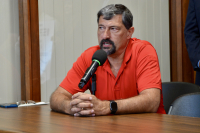Traveling south to find America

“Appalachia can give us an eye towards how the national personality refracts like a diamond into a thousand rays” — Imani Perry
The subtitle to National Book Award-winning author Imani Perry’s new book “South To America” (Harper Collins, 2022, 383 pages) pretty much sums up the contents of the book: “A Journey Below the Mason-Dixon to Understand the Soul of a Nation.”
Written in a multi-genre style and what is a combination of travel memoir, history and social politics, Perry takes us on a road-trip through the South to some of its major cities and historic locations. Written with a personal flair as well as high-caliber penmanship, like a tour-guide, she, place by place, chapter by chapter, opens up the landscape and the history of the cotton-growing plantation South “to legitimize the fact that America and the U.S. was bred and raised on Southern economics, culture and ethics and remains so today.”
Imani Perry, a native of Alabama, who “grew up among people who eat both sweet and unsweet cornbread,” and who is currently on the faculty at Princeton University, starts her pilgrimage in West Virginia and Harper’s Ferry, and muses as she looks through the windows into the historic train station there that honors John Brown who led the slave revolt there in 1859: “From a child (John Brown) loved to dwell beneath the open sky. The many voices of the woods, and fields, and mountains, spoke to him a familiar language. He understood the habits of plants and animals of birds and trees and flowers ....” She then quotes Edgar Allan Poe, whose ancestors were from the mining cultures of Alabama and South Carolina, and who preferred the name Appalachia to the given name for the new nation of Alleghania. Perry’s sojourn in Appalachia then moves south and slightly west through the mountains of Kentucky and then to Tennessee.
From Appalachia, we go a little eastward to Virginia to the Shenandoah Valley and Charlottesville and the home of Thomas Jefferson at Monticello, as Perry mentions that a significant number of her ancestors were 18th century Virginians. On this Virginia sojourn we visit Newport News, Norfolk, Jamestown and Williamsburg — all in the “breadbasket of the Confederacy.” From Virginia we go west again to Louisville, Kentucky. “Although Kentucky stayed in the Union, it was never a completely Union-identified state. Perhaps the most telling evidence of this is the song ‘My Old Kentucky Home,’” Perry writes and goes on to mention the love for horse racing (the Kentucky Derby) and Kentucky bourbon.
From Kentucky we slide up and over to Annapolis, Maryland. “I wanted to travel to Maryland, to see something about my ancestral beginnings. The Mason-Dixon Line sits at the bottom of the state in which I live, Pennsylvania, and at the top of Maryland.” she says. “Some refer to this part of the country as the ‘urban South,’ but you’d be hard-pressed to find a Deep Southerner who would ever call Maryland or Washington, D.C., the South,” she continues (as she wanders up and down the brick streets near the water in Annapolis in block-heeled sandals that were giving her big blisters and where the market was established for people to sell their wares). From Annapolis we go to Boonsboro to visit the Crystal Grottoes that are sink-holes that collapsed into an underground grotto of caves that are now a favorite tourist destination and which is the sight of significant early American history.
Related Items
And then we are on to “the ironic capital” of Washington, D.C., along the Potomac River, where, as one might imagine, we visit malls, monuments and national museums — symbolic of much of American history as we know it — as well as also visiting the underbelly and the unknown not detailed in American educational history books.
Following the initial section titled “Origin Stories,” section II is titled “The Solidified South,” and includes stops in Upper Alabama, including a trip to Huntsville and Perry’s family home of her great-great-grandmother. Then on to Muscle Shoals known for the plethora of well-known music groups and artists such as Aretha Franklin, Wilson Pickett, Joe Cocker, Willie Nelson and James Brown that either came from there or evolved from Muscle Shoals Sound Studios back in the 1960s. From Alabama we’re on to “Tobacco Road in the Bible Belt” and familiar territory here in “the new South” of North Carolina. Quoting Faulkner, Perry takes us to Cape Fear, Wilmington, Durham and Duke University (where she studied in a graduate program in the 1990s), and Greensboro, also mentioning James Taylor’s N.C. history and his song “Carolina On My Mind.”
From North Carolina, it’s on to Atlanta and what Perry calls “the King of the South” — a city of establishment and excess; or “the cutting edge on unsteady ground.” And from Atlanta we travel to Nashville and Memphis, both cities also famous for their legendary musical traditions.
In the last section of “South to America” titled “Water People,” we visit the seashore vista of Sea Island, Georgia, and the Gullah Geechee culture on the way to Savannah with its counter-culture and fine dining. Then it’s on to Florida and New Orleans and finally to “paradise” in the Bahamas and Havana, Cuba. What a trip, as we used to say back in the 1960s. Quite the journey of hotspots in the South related to American history. Or, as Perry concludes: “If America is to be salvific, it can only be so because underneath our skyscrapers lie the people who have tasted the red clay, the loamy soil. If their dreams can become ‘we’ dreams, hope will spring. And if we want it, if we aren’t afraid to grab it, we have to look South, to America.”
(Thomas Crowe is a regular contributer to The Smoky Mountain News and author of the multi-award-winning non-fiction nature memoir Zoro’s Field: My Life in the Appalachian Woods.)









